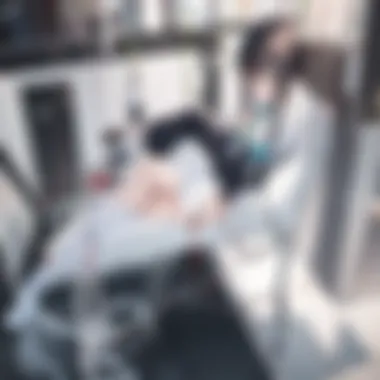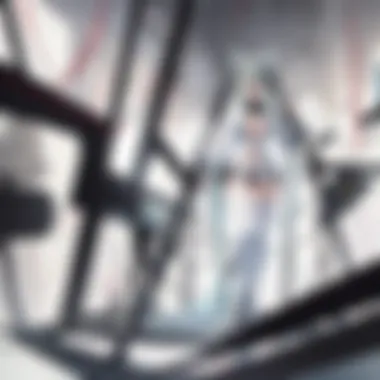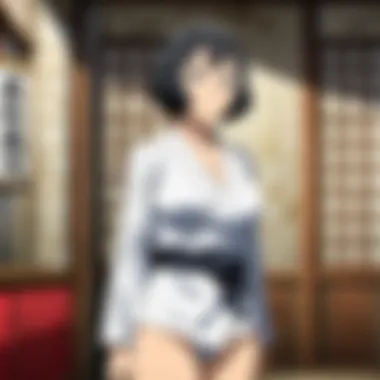Shimoneta Episode 1: An In-Depth Analysis


Intro
The first episode of Shimoneta unfolds in a society tightly controlled by extreme censorship. It introduces a world where lewdness is banned and the public is conditioned to suppress any thought of sexual topics. This sets the stage for a critical exploration of themes that resonate with contemporary issues surrounding freedom of expression and moral boundaries.
In examining this episode, we will look closely at how it not only establishes the narrative's trajectory but also introduces significant characters that embody both rebellion and conformity. In doing so, we will unravel the underlying socio-political commentary that provides context to the bizarre yet insightful world of Shimoneta.
Foreword to Shimoneta
The anime series Shimoneta offers a provocative yet entertaining lens through which to examine societal norms, especially concerning censorship and freedom of expression. This introduction serves to outline the significance of the show, as well as the context of its first episode. By focusing on these elements, one gains insight into the vibrant, often contentious discussions surrounding moral and ethical boundaries in media.
Overview of the Series
Shimoneta: A Boring World Where the Concept of Dirty Jokes Doesn’t Exist delves into a future Japan where censorship is taken to an extreme level. The government enforces severe restrictions on speech and expression, particularly those related to sexuality. The series masterfully juxtaposes humor with serious societal critique. This anime appeals to audiences not only for its comedic value but also for its exploration of deep-rooted issues surrounding morality, communication, and personal freedom. By offering a unique premise, Shimoneta engages viewers to reflect critically on their own world, the implications of censorship, and the nature of taboo.
Context of Episode
The first episode serves as the groundwork for establishing the series' dystopian world. It introduces the audience to the harsh reality of this society, where moral constraints dictate behavior and limit personal expression. Viewers meet the protagonist, Tanukichi Okuma, whose internal conflict between conforming to societal rules and embracing his desires provides a compelling narrative foundation.
This episode not only sets the tone for the entire series but also encapsulates key themes that will be explored going forward. It effectively blends a satirical take on censorship with moments of dark comedy, raising essential questions about the implications of living in a controlled society. As viewers navigate these early scenes, they are invited to consider how extreme censorship might shape human behavior and relationships.
Setting the Stage
The concept of setting the stage in the context of "Shimoneta Episode 1" plays a crucial role in establishing the narrative's foundation. It provides the necessary backdrop that shapes character interactions, plot developments, and thematic explorations. By delving into the elements of dystopian world-building and the distinctive visual style, the audience grasp the complexity of the story.
Dystopian World-Building
Post-Censorship Society
The post-censorship society depicted in the series is integral to understanding the overarching narrative. In this world, strict regulations on expression and morality dictate individual behavior. The key characteristic of this setup is how it highlights the absurdity of excessive censorship. This aspect is a beneficial choice as it reflects real-world issues surrounding freedom of speech and the consequences of overreaching authority in society. The unique feature here is the extreme measures taken to stifle personal freedom. This draws a significant parallel to modern debates on censorship, showcasing both advantages—such as safety—and disadvantages, like loss of individuality.
Moral Constraints
Moral constraints in this society serve to emphasize the conflicts between personal desires and societal expectations. These constraints not only drive the plot but also reveal the philosophical dilemmas faced by characters. The key characteristic of moral constraints is their prescriptive nature, impacting interpersonal relationships. This serves as a popular choice, as it allows for a reflection on contemporary moral standards. The unique feature of these constraints is their basis in an exaggerated moral panic, which serves the narrative by creating tension but also risks oversimplifying complex moral discussions.
Behavior Control
Behavior control is another significant aspect explored through the series. This control manifests in the form of surveillance and rigid societal norms that individuals must adhere to. The main characteristic of behavior control is its pervasive nature, effectively monitoring citizens' actions and thoughts. This is essential for the article since it visually represents how authoritarian systems can distort personal freedom. The unique feature of this control is the absurdity present in how characters navigate daily life under such scrutiny. While it enhances the storytelling, it also raises questions about the feasibility and ethical implications of such systems in the real world.
Visual Style and Animation
Character Designs
Character designs are pivotal in conveying the narrative's tone and informing viewers about personalities. The key characteristic is their exaggerated features, which often hint at underlying traits. This choice is popular as it helps distinguish characters clearly in a vibrant world. The unique feature here lies in the mix of traditional traits with modern aesthetics, which makes characters immediately relatable and memorable. However, characters may occasionally come across as caricatures, which could detract from depth.
Color Palette
The color palette employed throughout "Shimoneta" is bright and engaging, drawing viewers into its bizarre environment. The key characteristic of this palette is its vibrancy, which contrasts sharply with the serious themes explored. This choice enhances the sense of irony in the narrative, making it a beneficial tool for engagement. The unique feature is the use of bold colors paired with occasional muted tones, adding visual depth. However, some may critique this approach as it risks overshadowing more serious moments with overwhelming visuals.
Animation Quality
Animation quality in the series plays an essential role in delivering the story effectively. The key characteristic here is fluid animation that captures both action and emotional nuances. This aligns well with the article’s intent to analyze character dynamics and thematic depth. The unique feature of the animation is its attention to detail, creating a rich viewing experience. While the overall quality contributes positively, inconsistent frames may arise, affecting immersion at times.


Character Preludes
Understanding the character introductions in Shimoneta Episode 1 is crucial for grasping the narrative's key elements. Characters serve as the vehicle through which the audience engages with the story's themes. Their backgrounds, motivations, and relationships provide depth and context to the overarching plot. The dynamics among characters also reflect societal issues that the series critiques, especially regarding censorship and morality.
Tanukichi Okuma
Background
Tanukichi Okuma is introduced as a complex character shaped by a restrictive society. His upbringing in a post-censorship world has led to his internal conflict between adhering to societal rules and pursuing personal freedom. This contrast is central to the narrative, allowing exploration of themes around individualism and repression. His character is relatable for viewers, as many people experience similar struggles in oppressive environments. The multifaceted nature of his background serves to ground the overall story in realism, making it a strong element in the article's analysis.
Motivations
Tanukichi's motivations reveal his desire for autonomy within an authoritarian framework. His longing to challenge societal norms that suppress desire showcases the human spirit's resilience. This characteristic is vital for the article, as it ties to broader themes of censorship and freedom of expression. His struggle is not merely personal but can be seen as symbolic of collective societal challenges. This brings an added layer of resolution for readers, underscoring the exploration of behaviors constrained by extensive moral policing.
Role in the Narrative
As the protagonist, Tanukichi's role is integral to driving the plot. His actions and decisions act as a catalyst for interactions with other characters, notably Ana Yuki. This dynamic complexity enriches the narrative structure and discussion of character relationships in the article. His position enables the audience to experience the dystopian world firsthand, allowing deeper engagement with the thematic elements. By crafting Tanukichi as a relatable character, the series invites viewers to reflect on their own experiences regarding morality and personal freedoms.
Ana Yuki
Characteristics
Ana Yuki is portrayed as a bold and assertive character. Her unfiltered personality sharply contrasts Tanukichi's more reserved nature, creating an immediate tension between the two. This contrast is significant for the article because it highlights varying approaches to societal norms. Ana's distinctiveness enhances the character development arc and propels the narrative in unexpected directions. Her character traits provide a clear lens through which viewers can interpret the moral dilemmas presented.
Impact on Tanukichi
Ana Yuki's influence on Tanukichi is profound. She pushes him to confront his beliefs and the constraints imposed by their society. This interaction serves as a crucial point in the narrative and is discussed in the article as a turning point. Ana's more liberated outlook encourages Tanukichi to reevaluate his approach to self-expression. The impact she has on him can also be seen as symbolic of broader social movements advocating for change in oppressive contexts, adding relevance to the character studies presented.
Her Agenda
Ana Yuki's agenda is centered around challenging the societal status quo. Her goals drive a significant portion of the plot. This aspect of her character is essential as it aligns with the themes of rebellion and freedom. The article examines her perspective as not just a personal quest but as part of a larger commentary on opposition to censorship. This agenda shapes her interactions and underscore the significance of taking a stand against perceived moral failures in governing structures.
Supporting Characters
Character Dynamics
The supporting characters in Shimoneta play pivotal roles in enhancing the narrative. The relationships they form with Tanukichi and Ana are rich with tension and complexity. These dynamics reflect varying attitudes towards censorship and morality, which are essential to the article's discourse. By analyzing these interactions, one can understand how the show constructs its critique of societal norms in a nuanced manner. The diversity of character opinions on freedom adds depth to the underlying themes.
Contribution to Plot
Supporting characters are not mere background figures; their contributions are crucial for propelling the plot. They catalyze critical events that impact Tanukichi and Ana’s journey. The article discusses how these elements contribute to a cohesive story while illuminating different facets of the main themes. This aspect shows how integral the entire cast is in shaping the narrative's trajectory and the viewpoints presented through various perspectives.
Foils and Allies
The supporting cast includes both allies and foils, each serving to highlight different aspects of Tanukichi and Ana's characters. Foils provide contrast that clarifies the protagonists' traits and motivations. Meanwhile, allies reinforce the discussion of themes present in the overarching narrative, such as camaraderie, rebellion, and conformity. The article reflects on how these relationships are instrumental in forming a comprehensive understanding of the characters' roles and the societal commentary inherent in the narrative.
Themes Explored
The themes presented in the first episode of Shimoneta are vital in understanding its narrative layers and societal commentary. The exploration of censorship intersecting with freedom of expression reflects the broader concerns of modern culture. Both themes provoke essential discussions around personal liberties, restrictions imposed by the state, and the societal impact of these dynamics. By delving into these themes, the article shines a light on critical considerations surrounding autonomy and the nature of morality within a heavily controlled society.
Censorship and Freedom of Expression
Societal Implications


Censorship stands as a predominant force in the narrative of Shimoneta. The manipulation of personal expression crafted by societal norms becomes a key talking point. One major aspect of this theme is the chilling effect censorship has on creativity and individual thought. It paints a picture of a world where ideas are controlled, resulting in a populace that may become apathetic or conformist. This characteristic is compelling because it resonates with current global discourse on the balance between societal order and personal rights. Censorship, as represented in the series, has both advantages and disadvantages; while it can promote stability, it often stifles innovation and free will.
Comparative Analysis with Reality
Shimoneta provides a striking commentary that invites viewers to reflect on their own world. The exaggerated portrayal of censorship in the anime mirrors real-world instances of freedom suppression. This direct reflection on events in various cultures makes the analysis insightful and relevant. By highlighting this comparison, the article can engage the audience's critical thinking on how censorship operates in their societies. A unique feature of this comparative aspect is how it encourages audiences to draw parallels, making them more aware of their surroundings. However, oversimplification could downplay the complexities of real-world censorship, which can be detrimental to the discourse.
Impact on Younger Generations
The representation of censorship in Shimoneta can directly influence younger viewers. By exhibiting the consequences of a repressed society, it educates its audience about the importance of freedom. The show raises awareness of personal liberties and the dangers of complacency. Young generations may perceive this portrayal as a cautionary tale, prompting engagement in dialogues about rights and responsibilities. However, one concern is that the exaggeration of these themes might lead to misunderstandings about the complexities of the real world. While it serves as a powerful narrative device, it is crucial for discussions around these topics to be nuanced in understanding.
Sexuality and Morality
Cultural Perspectives
Shimoneta tackles the depiction of sexuality through varying cultural lenses, emphasizing its multifaceted nature. This exploration brings to light the clash between traditional values and contemporary realities. The narrative suggests that understanding sexuality requires navigating differing cultural perspectives to appreciate its impact. This theme allows for broader frameworks that analyze how societies view sexual expression. It poses benefits regarding moral questioning but carries the downside of oversimplifying diverse attitudes towards sexuality through broad strokes, which may not capture their intricate nature.
Depiction of Sexuality
The episode's portrayal of sexuality is essential in observing societal norms. Specific scenes challenge viewers to consider their own expectations regarding sexual expressions. By depicting characters in contexts that question such norms, the series acts as a mirror reflecting societal attitudes. While this can spark necessary conversations, it risks reinforcing stereotypes if not handled delicately. The balance between free expression and the potential perils of misrepresentation creates a topic ripe for examination. It's a double-edged sword; insightful discussions can emerge, but it must be approached with care to avoid skewing perceptions unfairly.
Moral Dilemmas
The moral dilemmas presented in Shimoneta offer viewers a chance to grapple with significant questions regarding right and wrong within the story's framework. Characters find themselves facing situations that challenge their ethical beliefs, often leading to self-reflection. This theme is essential as it places morality in a critical light, prompting deeper analysis of the character's choices. However, while these dilemmas can provoke thought, they may also be criticized for simplifying complex issues to fit the narrative arc, potentially undermining the depth of moral questioning.
Narrative Structure
Narrative structure serves as the backbone of any story, guiding how events unfold and how the audience engages with the material. In discussions about Shimoneta Episode 1, it becomes imperative to analyze this aspect deeply. The narrative structure provides context for character development, theme exploration, and the pacing of the episode. By breaking down the plot development, pacing, and tone, we uncover how these elements intertwine to create a compelling viewing experience.
Plot Development
Key Events
Key events are pivotal moments that shape the overall trajectory of the episode. For Shimoneta, the introduction of a post-censorship society directly influences the characters and their motivations. The initial scenes present viewers with a stark contrast between everyday life and the oppressive rules governing society. This setup allows audiences to grasp the stakes involved, making these key events impactful.
An essential characteristic of key events in Shimoneta is their ability to highlight freedom of expression issues. These moments create a narrative framework that encourages viewers to reflect on the implications of censorship within their own lives. The unique feature of these key events lies in their provocative nature, forcing the audience to confront uncomfortable realities. The advantage here is a deeper engagement with the storyline but can also lead to polarized reactions among viewers.
Use of Humor
The use of humor is strategically woven into the narrative of Shimoneta Episode 1. It brightens the otherwise dark themes of censorship and repression, allowing for a diverse range of emotional responses from the audience. Humor serves as a vehicle for social commentary, providing moments of levity that juxtapose the serious undertones of the narrative.
A key characteristic of humor in this episode is its irreverence, poking fun at the absurdities of the society depicted. This element is beneficial as it allows for diverse interpretations of the underlying messages. The unique feature of humor here challenges norms and offers critique of societal standards while remaining accessible. However, the downside is that some viewers may miss the significant implications behind the humor, reducing the depth of discourse.
Foreshadowing
Foreshadowing in Shimoneta serves to hint at future events and deeper narrative threads. This technique not only builds anticipation but also enriches the viewer's understanding of the big picture. Through subtle cues, the episode lays the groundwork for future conflicts and character arcs, hinting at the overarching themes of morality and resistance against conformity.
The key characteristic of foreshadowing in this context is its effectiveness in creating suspense and intrigue. It prepares the audience for twists and turns that await them. Moreover, a unique feature of foreshadowing in Shimoneta is its blend of humor with serious themes, allowing for a seamless transition between different narrative elements. However, if overused, it could lead to predictability, potentially dulling the viewer’s excitement and engagement.
Pacing and Tone
Contrasting Scenes
Contrasting scenes play a vital role in achieving a varied narrative. In Shimoneta Episode 1, the juxtaposition of light-hearted moments with serious undertones increases the dramatic impact. This pacing strategy allows the audience to process difficult themes without becoming overwhelmed.


A key characteristic of these contrasting scenes is their ability to highlight themes of freedom and repression. The transitions from comedic to serious serve to reinforce the message of the narrative. The unique feature of this pacing technique is its effectiveness in promoting audience reflection. However, there is a risk of disjointedness if the contrast is not executed seamlessly, potentially leading to confusion.
Balancing Humor and Seriousness
Balancing humor and seriousness is essential for creating an engaging narrative that resonates. In Shimoneta, this balance is carefully maintained to ensure that the audience can appreciate the humor without undercutting the serious commentary. This technique allows the show to entertain while simultaneously provoking thought about societal issues.
A vital characteristic of this balance is how it addresses uncomfortable themes using humor as a lens. This approach fosters a conducive environment for discussion about censorship and morality. The unique feature of operating within this balance is its accessibility, making critical themes digestible for viewers. Nevertheless, missteps in this balance could alienate portions of the audience, making it essential for creators to tread carefully.
Reception and Critique
The reception and critique of an anime series like Shimoneta is crucial to understanding its impact and relevance in today's society. The discourse around audience reception can provide insight into how a narrative that challenges norms is received by viewers. This section will explore audience reactions and critical perspectives, revealing the complexity of themes interwoven in the episode.
Audience Reactions
Varied Perspectives
Audience reactions to Shimoneta Episode 1 highlight a broad spectrum of opinions. This variation is significant because it underscores the divisiveness of the show’s themes. Viewers often possess different backgrounds, experiences, and beliefs, which inform their interpretations. The key characteristic of diverse reactions is its potential to foster rich discussions within fan communities.
For instance, some may embrace the provocative content as a critique of censorship, while others find it distasteful or unnecessary. This is a beneficial choice for this article as it reflects on the real-world implications of censorship and sexual expression.
The unique feature of varied perspectives is its ability to reveal contradictions within society's views on morality. The benefits of this diversity lie in the opportunity for dialogue, while the disadvantage is the risk of misinterpretation or misunderstanding of the creators' intents.
Expectations vs. Reality
The expectations versus reality aspect of audience reception reveals how preconceptions influence viewer engagement. Many anticipated a humorous take on sex comedy, but the series delivers a darker critique of societal constraints. This key characteristic is particularly relevant as it illustrates a gap between what viewers want and what the narrative provides, contributing to a richer analysis of audience responses.
The unique feature of this discussion is its ability to highlight the tensions between societal norms and individual desire. This choice is beneficial as it prompts reflection on personal values against the backdrop of the episode's content. However, the downside might be some viewers feeling disappointed or alienated from the narrative.
Critical Acclaim and Controversies
Critics’ Views
Critics of Shimoneta have offered varied analyses that encompass both praise and disapproval. The critical discourse often revolves around its provocative themes and bold narrative choices. This is a significant aspect as it shows how the series challenges mainstream media. The key characteristic of critics’ views often centers on a recognition of the risks taken in conveying its messages.
This aspect provides a balance of opinions, crucial for the article's comprehensiveness. The unique advantage in this is the ability to navigate differing opinions, offering readers a nuanced understanding of the critical landscape. However, the disadvantage could be that overly negative critiques may overshadow the show's intentions.
Polarized Opinions
Polarized opinions often emerge in discussions surrounding Shimoneta Episode 1, reflecting the contentious nature of its themes. This characteristic highlights the extent to which certain subjects can divide audiences. The benefits of diving into polarized opinions lie in the exploration of cultural taboos and the varying reactions they invoke.
This discourse reveals a necessary tension that mirrors wider societal divides regarding topics like censorship and morality. A unique feature of this polarization is how it pushes viewers to confront their beliefs, whether they find the content liberating or offensive. While beneficial in stimulating dialogue, the risk is that polarization can also stifle productive conversation if viewers become too entrenched in their positions.
Overall, the section on reception and critique in this article offers a detailed examination of both audience and critic responses. It reflects the intricate relationship between art and societal values, making it a pertinent analysis for understanding Shimoneta Episode 1.
Finale
The conclusion serves as a vital component in reviewing Shimoneta Episode 1. It encapsulates the essential elements discussed throughout the article, reaffirming the significance of the themes, character explorations, and the overall narrative structure. This section not only summarizes the key points but also highlights the broader implications of the series in the context of censorship and societal norms.
Summary of Key Points
In summary, Shimoneta Episode 1 introduces viewers to a dystopian world where censorship dictates societal behavior. Key characters, including Tanukichi Okuma and Ana Yuki, establish the central conflicts that propel the narrative forward. Themes of censorship and freedom of expression resonate throughout the episode, prompting reflection on the impact of such restrictions in both fictional and real-world contexts. The episode employs humor and irony while exploring serious moral dilemmas, effectively balancing entertainment with deeper messages.
Implications for Further Episodes
The implications for future episodes are notable. As the series progresses, it is likely to delve deeper into the complexities of its established themes. Viewers may anticipate further character development, particularly regarding the motivations behind characters like Ana Yuki. Moreover, the initial discussions surrounding censorship raise questions about how the narrative will evolve in its portrayal of sexuality and morality in subsequent episodes. Understanding these trajectories enhances the viewing experience, encouraging audiences to engage critically with the material.
"Censorship is not simply a matter of rules; it is about the norms and values that shape society's moral compass."
The conclusion thus invites viewers to ponder the questions raised by the series, ensuring that the conversation around censorship and expression continues to be relevant as the story unfolds.



